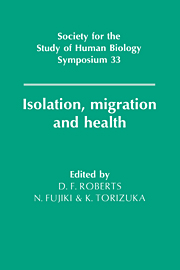Book contents
- Frontmatter
- Contents
- List of contributors
- Preface
- 1 The legacy of the IBP: Presidential Address
- 2 The distinction between primary and secondary isolates
- 3 Time trends in the break-up of isolates
- 4 Factors influencing the frequency of consanguineous marriages in Japan
- 5 Break-up of isolates
- 6 Isolates in India: their origin and characterisation
- 7 Consanguineous marriages and their genetical consequences in some Indian populations
- 8 Biomedical and immunogenetic variation in isolated populations in India
- 9 Genetic distance analyses in Israeli groups using classical markers and DNA polymorphisms in the β globin gene
- 10 Non-random distribution of Gm haplotypes in northern Siberia
- 11 Allele frequency estimation
- 12 Genetic affinities of human populations
- 13 Inherited neurological diseases in island isolates in southern Japan
- 14 Serological and virological evidence for human T-lymphotropic virus type I infection among the isolated Hagahai of Papua New Guinea
- 15 Analysis of genes associated with hypercholesterolaemia in the Japanese population
- 16 Migrant studies and their problems
- 17 Tokelau: migration and health in a small Polynesian society - a longitudinal study
- 18 Micromigrations of isolated Tuareg tribes of the Sahara Desert
- 19 Population structure in the eastern Adriatic: the influence of historical processes, migration patterns, isolation and ecological pressures, and their interaction
- 20 Diabetes and diabetic macroangiopathy in Japanese-Americans
- 21 Diabetes and westernisation in Japanese migrants
- 22 Environmental factors affecting ischemic heart disease
- Epilogue
- Index
8 - Biomedical and immunogenetic variation in isolated populations in India
Published online by Cambridge University Press: 05 March 2012
- Frontmatter
- Contents
- List of contributors
- Preface
- 1 The legacy of the IBP: Presidential Address
- 2 The distinction between primary and secondary isolates
- 3 Time trends in the break-up of isolates
- 4 Factors influencing the frequency of consanguineous marriages in Japan
- 5 Break-up of isolates
- 6 Isolates in India: their origin and characterisation
- 7 Consanguineous marriages and their genetical consequences in some Indian populations
- 8 Biomedical and immunogenetic variation in isolated populations in India
- 9 Genetic distance analyses in Israeli groups using classical markers and DNA polymorphisms in the β globin gene
- 10 Non-random distribution of Gm haplotypes in northern Siberia
- 11 Allele frequency estimation
- 12 Genetic affinities of human populations
- 13 Inherited neurological diseases in island isolates in southern Japan
- 14 Serological and virological evidence for human T-lymphotropic virus type I infection among the isolated Hagahai of Papua New Guinea
- 15 Analysis of genes associated with hypercholesterolaemia in the Japanese population
- 16 Migrant studies and their problems
- 17 Tokelau: migration and health in a small Polynesian society - a longitudinal study
- 18 Micromigrations of isolated Tuareg tribes of the Sahara Desert
- 19 Population structure in the eastern Adriatic: the influence of historical processes, migration patterns, isolation and ecological pressures, and their interaction
- 20 Diabetes and diabetic macroangiopathy in Japanese-Americans
- 21 Diabetes and westernisation in Japanese migrants
- 22 Environmental factors affecting ischemic heart disease
- Epilogue
- Index
Summary
Although there is a wealth of information available about genetic variation for tribal, rural, semi-urban and urban populations in India (Papiha, 1986), there is as yet little well-documented evidence to suggest how systematic and non-systematic pressures have influenced the present-day genetic pattern.
The majority of Indian populations carry a considerable load of diseases of environmental and especially infectious origin that contribute to childhood mortality. An extreme example is that of the Onge, a negrito tribe from the Andaman Islands. Already much depleted by the ravages of disease imported in the 19th century with the establishment of a penal settlement on the islands (Cappieri, 1947), over the last two to three decades the Onge population has decreased by 80%, and one severe epidemic could wipe out the remaining population.
In India, moreover, there is a wide variety of ecological zones, with their different distributions of vectors of bacterial and parasitic diseases, so that the pattern of human infestation varies from one to another. In spite of extensive efforts, malaria is still periodically experienced, and during the malarial epidemics mortality in certain regions reaches a level 30 times that in normal times, especially in young children (Kirk, 1986). Therefore, it is obvious that selective pressures differing qualitatively and quantitatively are being exercised on different populations in India.
As a measure of the body's defence mechanisms against disease, perhaps the most sensitive is the level of circulating antibodies, or the proteins known as immunoglobulins. The first part of this study assesses the variation in the level of immunogobulins in different tribal, caste and urban populations as an indicator of ecological stress.
- Type
- Chapter
- Information
- Isolation, Migration and Health , pp. 75 - 86Publisher: Cambridge University PressPrint publication year: 1992
- 1
- Cited by



